MARIANI’S
Virtual
Gourmet
June 12, 2022
NEWSLETTER
Founded in 1996
ARCHIVE
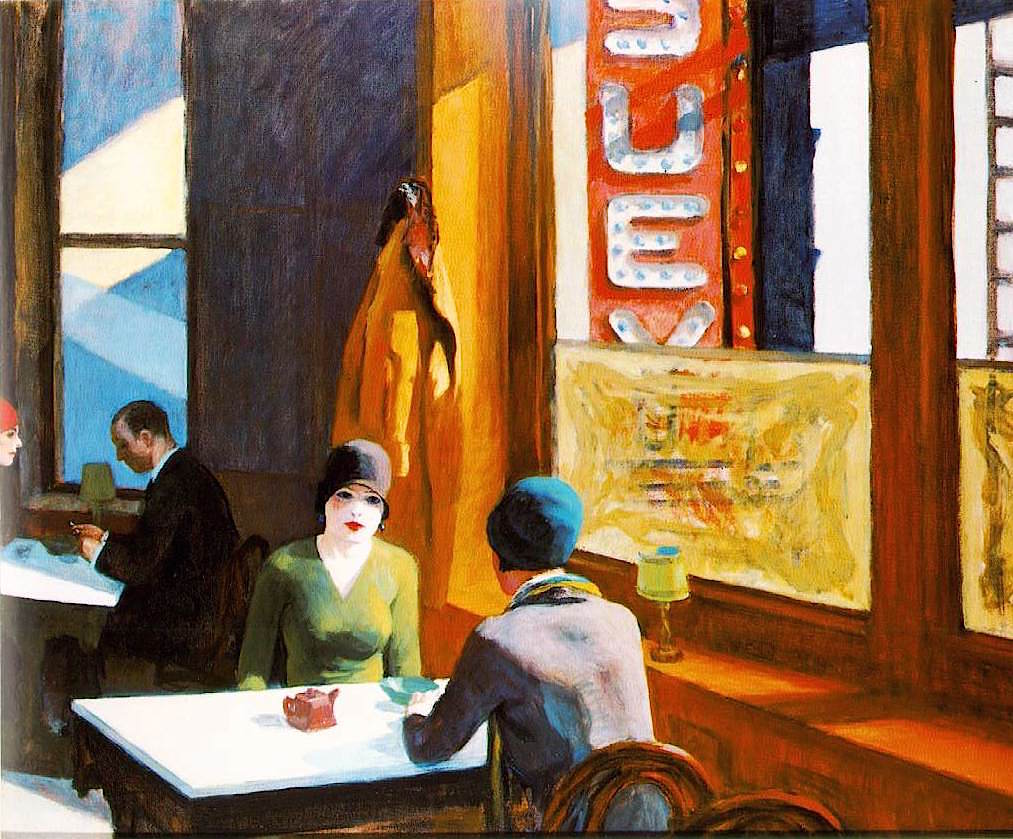
"Chop Suey" by Edward Hopper (1929)
IN THIS ISSUE
DINING OUT IN DUBLIN,
PART ONE
By John Mariani
NEW YORK CORNER
NERAI
By John Mariani
ANOTHER VERMEER
CHAPTER 23
By John Mariani
NOTES FROM THE WINE CELLAR
MAKING AND MARKETING CHAMPAGNE IN A WIDE MARKET:
AN INTERVIEW WITH G.H. MUMM
By John Mariani
❖❖❖
 Paul Kennedy
on his new book Victory at Sea. Go
to: WVOX.com.
The episode will also be archived at: almostgolden.
Paul Kennedy
on his new book Victory at Sea. Go
to: WVOX.com.
The episode will also be archived at: almostgolden.
❖❖❖
DINING IN DUBLIN,
Part One
By John Mariani
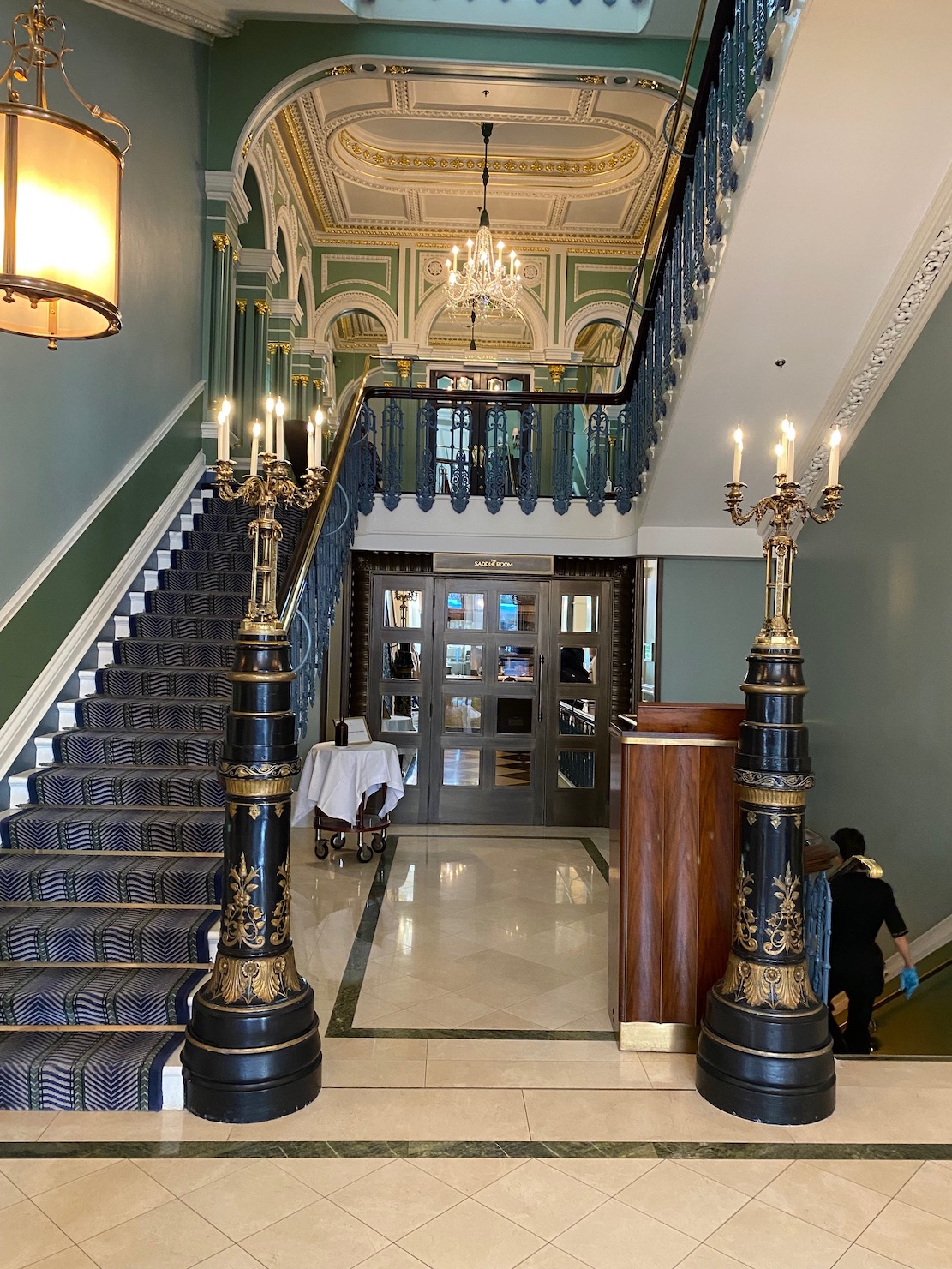
Entrance to The Saddle Room at the Shelbourne Hotel
Whether it was the pandemic or natural
causes, including greed-driven landlords,
Dublin’s restaurant scene has changed
considerably over the past three years. The
highly popular Coppinger Row was closed by a
developer; the critically acclaimed Greenhouse
is shuttered, as is Derry Clarke’s long-standing
L’Écrivain and the acclaimed Thornton’s. The Tea
Room at the Clarence Hotel is now a gastro-pub
called Cleaver East.
Fortunately, the city’s standard bearer for
fine French cuisine, Patrick
Guilbaud at The Merrion Hotel, is still
doing well, the Brasserie
at the Marker thrives, Roly’s
Bistro is always packed and Ananda
is still one of Europe’s finest Indian
restaurants.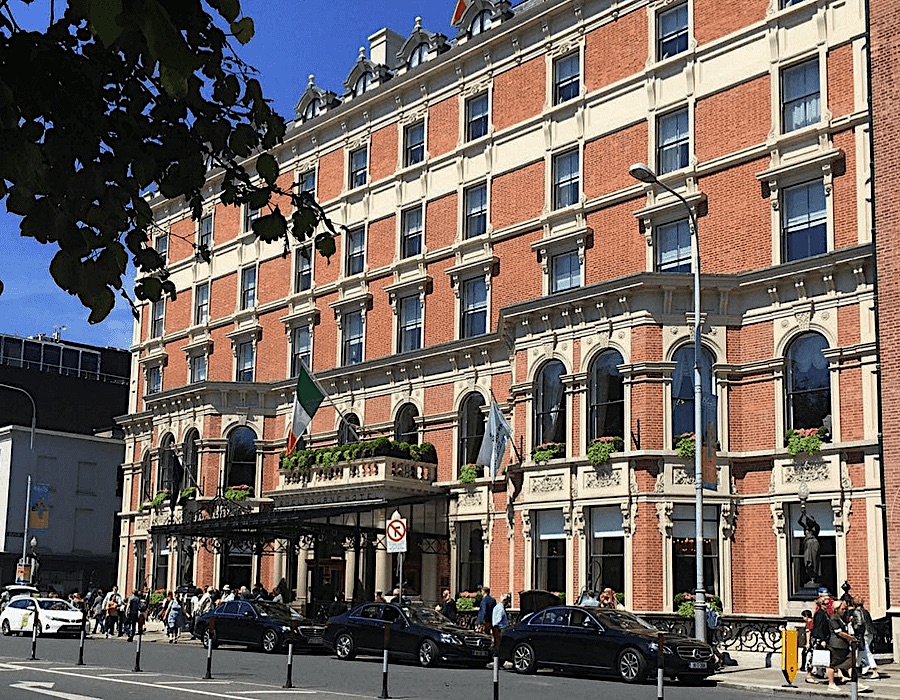 The historic Shelbourne,
(left; 27
St. Stephen’s Green), which
was taken over by Marriott, has never been in
better shape, architecturally or gastronomically,
after an eighteen-month restoration, now with 285
rooms.
The historic Shelbourne,
(left; 27
St. Stephen’s Green), which
was taken over by Marriott, has never been in
better shape, architecturally or gastronomically,
after an eighteen-month restoration, now with 285
rooms.
Located across from St. Stephen’s Green,
the hotel opened in 1824 as three townhouses,
named after William Petty, 2nd Earl of Shelburne.
Its most
infamous moment was during the Easter Rising of
1916, when 40 British soldiers holed up there to
oppose the rebels. In 1922 the Constitution of the
Irish Free State was drafted in Room 112.
Stately but so beautiful and well-lighted
as to be wholly welcoming, the public rooms are
decorated with superb Beaux Art sculptures by
Mathurin Moreau. As you enter, on the left is No.
27 The Shelburne Bar, serving cocktails and light
fare, including a fine shellfish platter; on the
right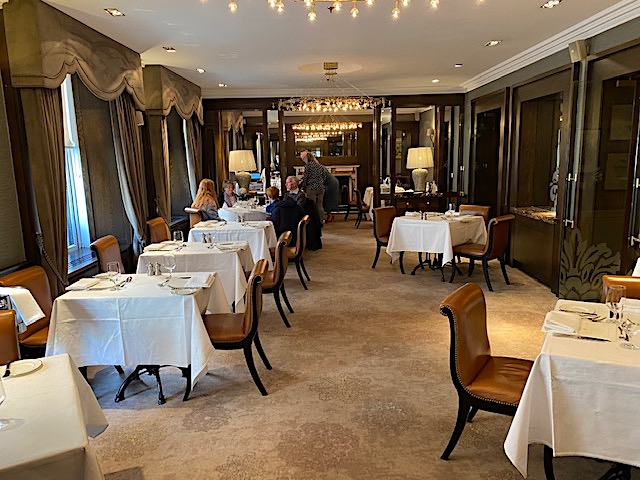 is the sunny
Lord Mayor’s Lounge, location for Dublin’s
loveliest afternoon tea. There is also the
Horseshoe Bar, opened in 1957, done in darker,
pub-like colors and upholstery. Atop the main
staircase the new 1824 Bar is a tad more
sophisticated.
is the sunny
Lord Mayor’s Lounge, location for Dublin’s
loveliest afternoon tea. There is also the
Horseshoe Bar, opened in 1957, done in darker,
pub-like colors and upholstery. Atop the main
staircase the new 1824 Bar is a tad more
sophisticated.
And then there is the very elegant but not
at all stuffy Saddle Room
(right), L-shaped, with booths off a
wonderful corridor opening into a long dining room
impeccably set and pleasantly civilized. My first
meal in Dublin was at the Saddle Room, and, within
its calm and gentility, nothing could have cured
my jet lag better with food of such a high
caliber.
Chef
Gary Hughes sets what might be called a “proper
menu,” drawing on the best Irish ingredients and
balancing Irish tradition with classical
refinement in dishes like a smooth terrine of
slowly braised Grannagh ham with a tangy mustard
aïoli and kohlrabi rémoulade. Luscious and silky
cured Castletownbere salmon (below) comes
on a sourdough crisp with a light buttermilk and
horseradish emulsion.
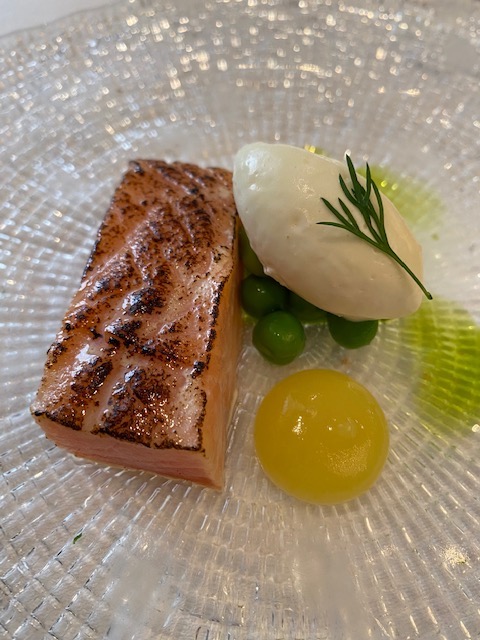 On the day I visited the soup of the day
was a creamy wild mushroom potage with truffled
foam. Among the main courses was Sherlock chicken
as deeply flavorful as the best poultry I’ve had
in France, with a crusted potato terrine, wild
mushrooms and truffled cream. I had no complaints
about the Daube of Charleville beef, gorgeously
rosy and scented with rosemary, with roast chateau
potatoes, a Burgundy wine reduction and Yorkshire
pudding, except that I’m spoiled by American
corn-finished
On the day I visited the soup of the day
was a creamy wild mushroom potage with truffled
foam. Among the main courses was Sherlock chicken
as deeply flavorful as the best poultry I’ve had
in France, with a crusted potato terrine, wild
mushrooms and truffled cream. I had no complaints
about the Daube of Charleville beef, gorgeously
rosy and scented with rosemary, with roast chateau
potatoes, a Burgundy wine reduction and Yorkshire
pudding, except that I’m spoiled by American
corn-finished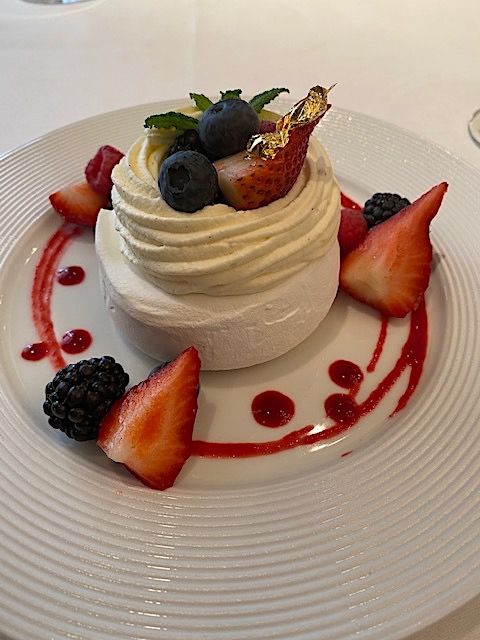 beef over
Europe’s less fatted grass-fed steers.
beef over
Europe’s less fatted grass-fed steers.
The wine list is well constructed to appeal
to those who have no desire to blow more than
€100, with many bottlings below €50. For
dessert, Hughes sent out a delicately crisp
meringue Pavlova (right) with mixed
berries, and a crème anglaise with pear puree and
rum-raisin ice cream.
Such a lunch is bargain priced at two
courses for €34, three for €38; at dinner dishes
are offered à la carte with main courses €50 to
€55 and a three-course table d’hôte at €65.
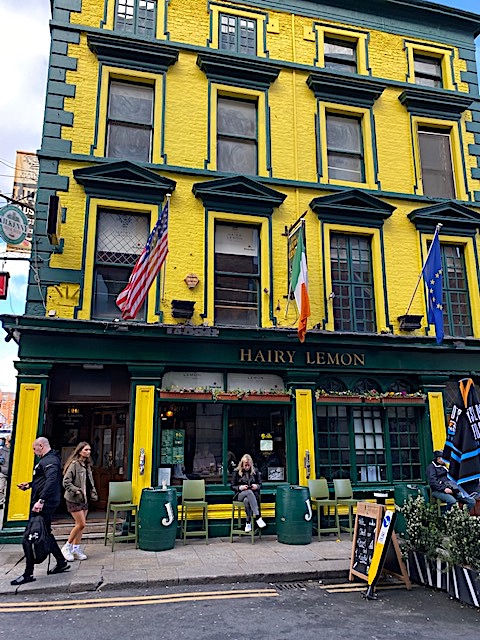 The
next day I was in more of a mood for good pub
food, and fish and chips in particular. Such fare
is widely available, and Beshoff’s, with several
food shops, is famous for its version, but I felt
more in need of an immersion into the buoyant
atmosphere of a pub. A trustworthy recommendation
was the Hairy
Lemon (41-42
Stephen Street Lower), whose unappetizing
name (after a bearded, yellow-faced dog catcher of
the 1940s) was quickly forgotten on entering a
packed pub with two dining rooms decorated with
all the usual Bushmills and Guinness signs,
blackboard menus and well-worn bar.
The
next day I was in more of a mood for good pub
food, and fish and chips in particular. Such fare
is widely available, and Beshoff’s, with several
food shops, is famous for its version, but I felt
more in need of an immersion into the buoyant
atmosphere of a pub. A trustworthy recommendation
was the Hairy
Lemon (41-42
Stephen Street Lower), whose unappetizing
name (after a bearded, yellow-faced dog catcher of
the 1940s) was quickly forgotten on entering a
packed pub with two dining rooms decorated with
all the usual Bushmills and Guinness signs,
blackboard menus and well-worn bar.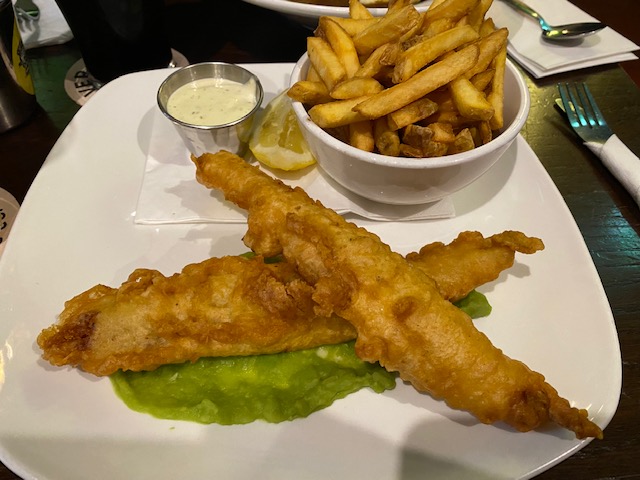 The waitresses, who, as all over town, included
several from eastern Europe, were fleet-footed and
had just the right amount of sass.
The waitresses, who, as all over town, included
several from eastern Europe, were fleet-footed and
had just the right amount of sass.
What came to the table was exceptionally
crisp, golden fried cod with
tartar sauce and a mound of highly satisfying
chips (French fries)(€17), as well as a hearty and
abundant Irish stew made with juicy chunks of beef
braised in Guinness and topped with puff pastry,
sided with potato and brown bread (€17). Seen on
many other tables were Bangers and Mash with onion
gravy (€16).
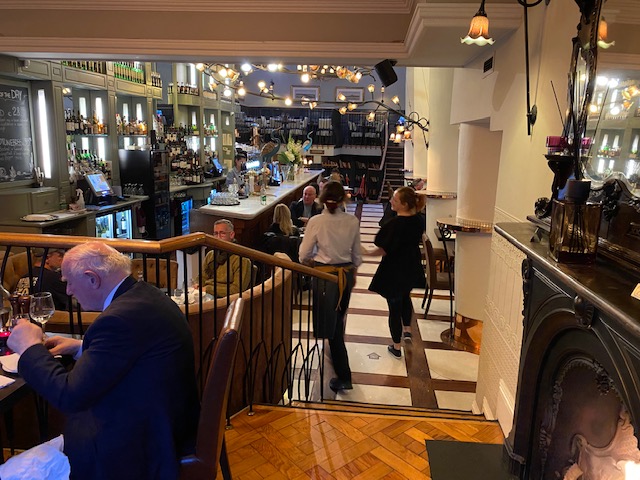 Somewhere in
between dining at the Shelbourne and the Hairy
Lemon is another oddly named restaurant, the
award-winning Matt the
Thresher (31-32 Lower
Pembroke Street), a very handsome two-level,
two-room city center seafood place near Merrion
Square, with tiled and wooden floors, wrought-iron
banisters, skylight and chandeliers, a great long
marble bar with shining brass spigots, a bookshelf
wall and a fireplace flanked by easy chairs. If I
owned a restaurant, this is what it would look
like.
Somewhere in
between dining at the Shelbourne and the Hairy
Lemon is another oddly named restaurant, the
award-winning Matt the
Thresher (31-32 Lower
Pembroke Street), a very handsome two-level,
two-room city center seafood place near Merrion
Square, with tiled and wooden floors, wrought-iron
banisters, skylight and chandeliers, a great long
marble bar with shining brass spigots, a bookshelf
wall and a fireplace flanked by easy chairs. If I
owned a restaurant, this is what it would look
like.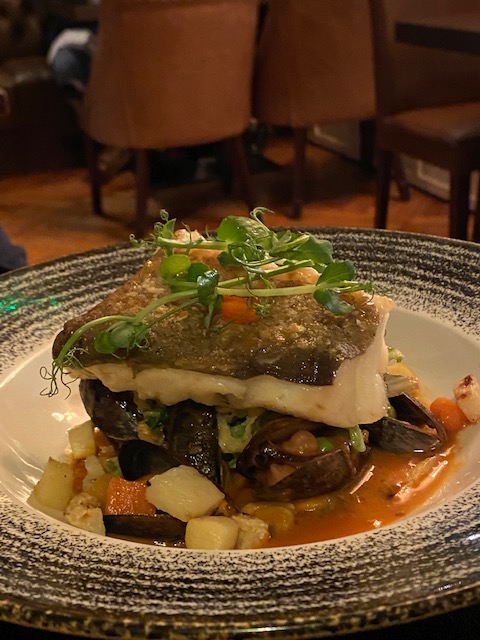
The restaurant is named after “Matt Donovan
in Charles Cook’s book about the Houses of
Tipperary and the characters who lived in them as
of 1879 . . . Matt the Thresher famously won a
sporting battle against the English officer
Captain French near Birdhill in 1860.”
The catch of the day is listed on
blackboard menus and recited by exceptionally
amiable waitresses. You can fill up on a variety
of oysters from Carlingford, Connemara and
elsewhere (a dozen for €35) or opt for a Dublin
Bay prawn cocktail generously piled with fresh
sweet crustaceans (€17.50). There are also seafood
platters (€25 to €90). We ordered two of the
night’s special fish dishes: snowy cod (right)
came with a bean cassoulet and root vegetables on
Savoy cabbage (€28.95), and stone bass was pretty
beside beetroots and fennel salsa, mangetout, bean
sprouts and a lush red pepper coulis (€33.95).
Matt’s has a superb wine list with
selections from all over the world, fairly
tariffed and courteously poured. There is also an
assortment of teas and coffees offered.
For
dessert you might prefer an Irish artisan cheese
plate with raisin chutney (€8) or a delightful
white chocolate and raspberry panna cotta (€8).
❖❖❖
NERAI
212-759-5554
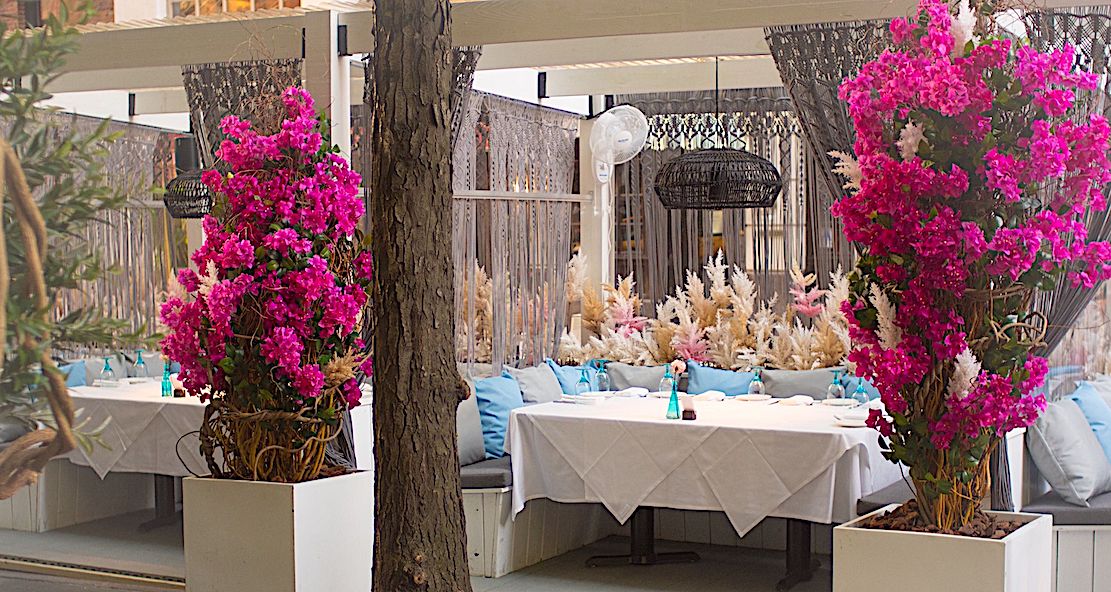
By John Mariani
“Neraida”
is Greek” for “mermaid,” which, shortened
to Nerai, is the prettiest name for a restaurant
since Piraeus, My Love closed. Nerai has been
around for a decade now, and,
while always a place of refinement, its acquiring
of a new chef,
Aaron Fitterman, has elevated the cuisine
even further without moving away from its roots.
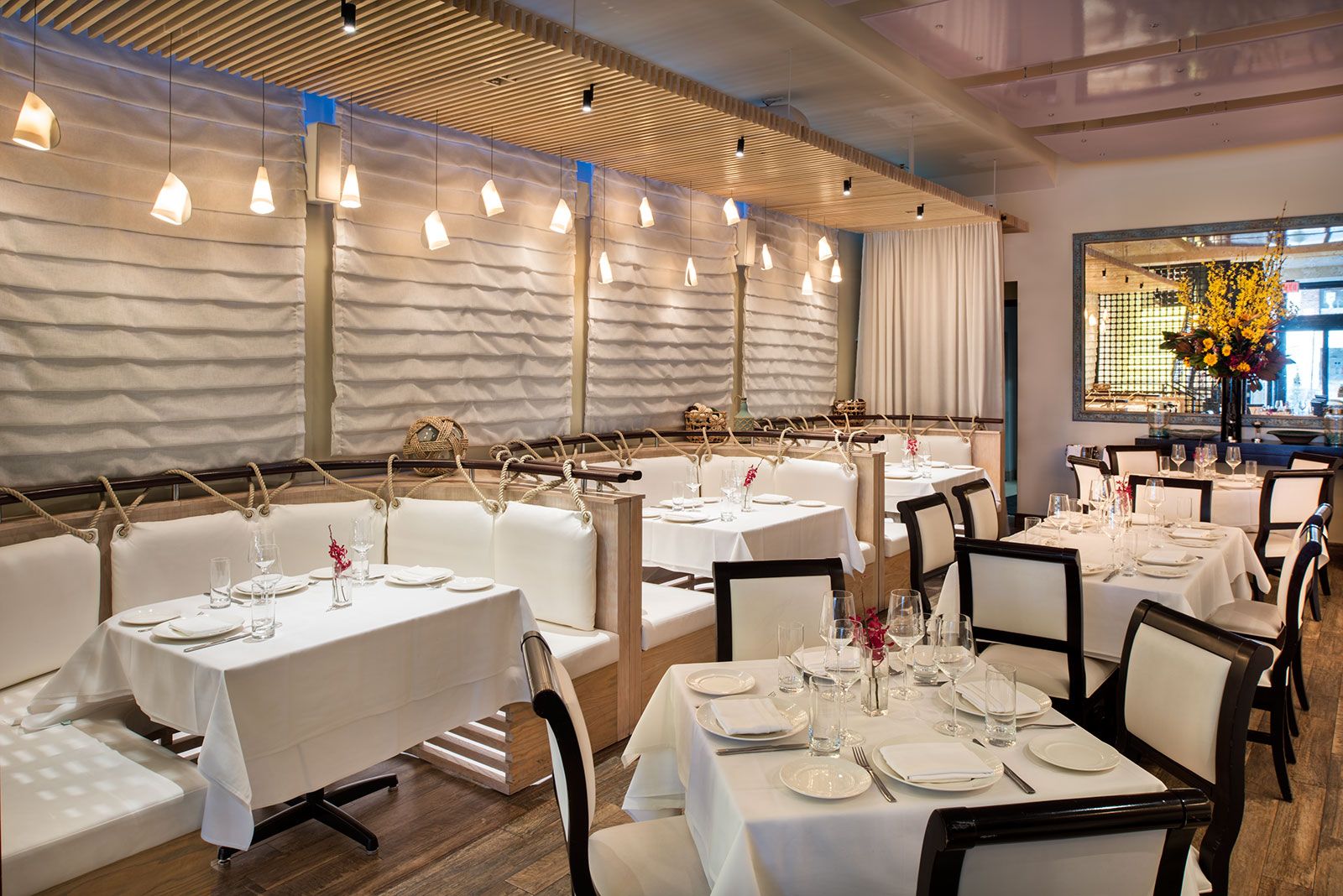 The
two-story restaurant, with a charming covered
patio and tables in a shed on the street, has
never looked fresher and better, with flattering
lighting set above the tables, making the
whitewashed walls glow. Good napery drapes tables
set with summer’s flowers—a great rarity these
days in even the finest restaurants—and both
banquettes and chairs are very comfortable, as is
the
The
two-story restaurant, with a charming covered
patio and tables in a shed on the street, has
never looked fresher and better, with flattering
lighting set above the tables, making the
whitewashed walls glow. Good napery drapes tables
set with summer’s flowers—a great rarity these
days in even the finest restaurants—and both
banquettes and chairs are very comfortable, as is
the 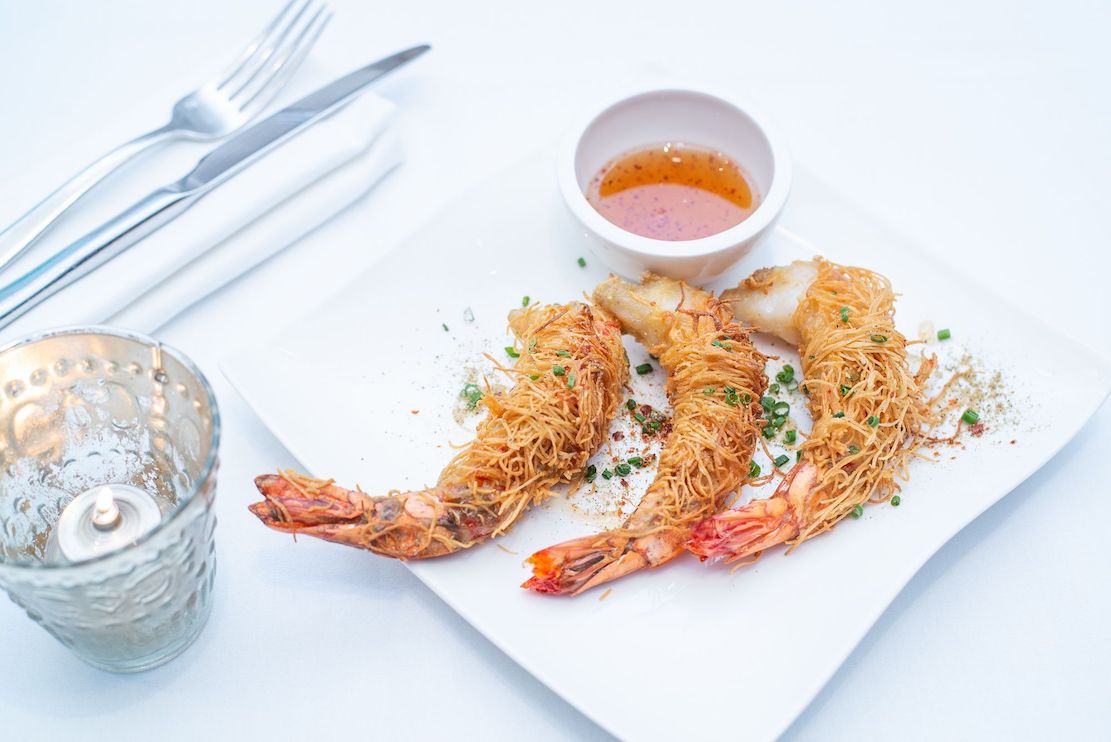 noise level (left).
noise level (left).
On a rainy June night we dined under the
patio’s rustic reed-thatched roof that was soon
being pounded by a thunder-and-lightning storm
that could have driven Odysseus, his “knee-joints
slackened,” off course. The contrasting drama of
the torrent with the cozy proceedings of our meal
inside made it all the more comforting, and the
fleet-footed waitstaff, overseen by manager
Christopher Feeney, just ignored the gods’ tremors
above us.
The wine list, under sommelier Dimitrios
Karagiannis, is lengthy and global, with, of
course, a plethora of Greek wines, most at a
reasonable mark-up, with many reds and whites
under $100 you won’t readily find in stores.
Chef Fitterman is assuredly not Greek, but
his twenty years of experience at notable kitchens
like Tabla, Five Points and, for the past eight
years, as Executive Chef at Aretsky’s Patroon,
inform his command of technique, especially with
seafood, and Nerai’s owners, Spiro Menegatos and Dinos Gourmos,
have given him the nod to buy the highest quality
products across the board. Unlike the astonishing
high tariffs at Estiatorios Milos on the West
Side, where fish is priced by the pound; at Nerai
it’s a set price.
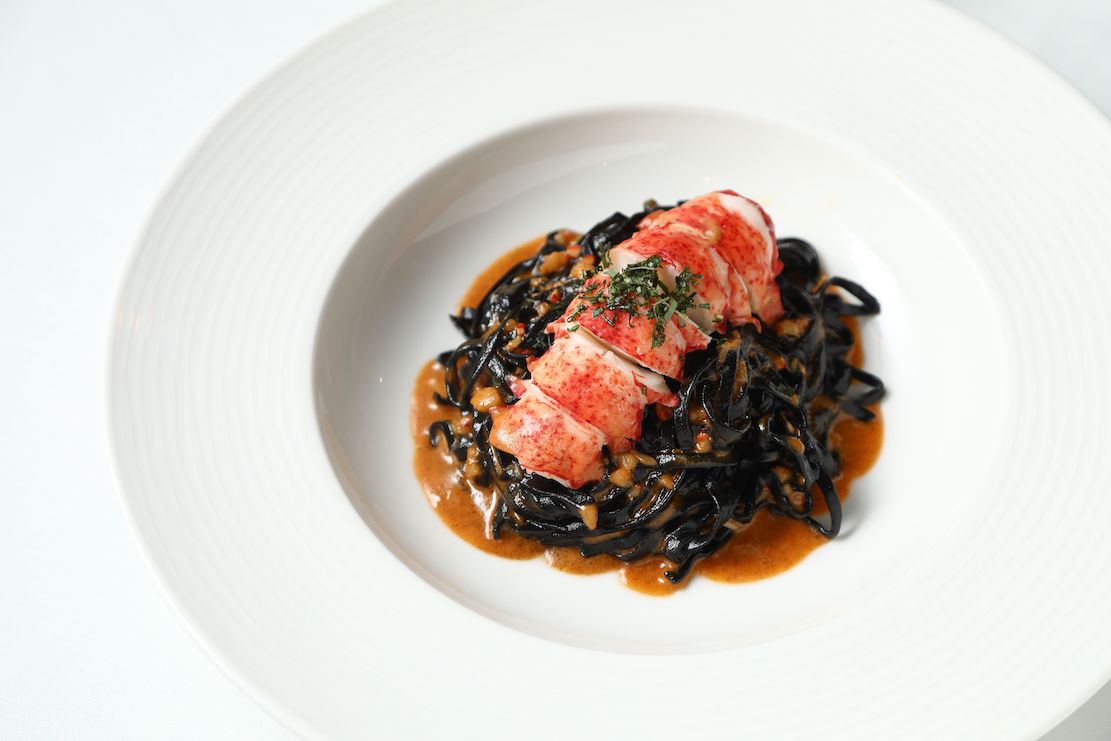 You
might well start off with a trio of traditional
spreads with grilled pita ($23). (By the way, pita
at Greek restaurants usually comes to the table as
complementary bread; at Nerai, you’ll have to ask
for it.) I highly recommend the individually
wrapped little spinach tarts mixed with dill and
feta and ouzo-laced yogurt ($18). Greek salads are
often a big mess of pre-prepared ingredients but
at Nerai they are pleasingly made to order ($22)
with tomatoes, feta, cucumber, onions, olives and
tomato butter, although tomatoes are far from
their best this time of year.
You
might well start off with a trio of traditional
spreads with grilled pita ($23). (By the way, pita
at Greek restaurants usually comes to the table as
complementary bread; at Nerai, you’ll have to ask
for it.) I highly recommend the individually
wrapped little spinach tarts mixed with dill and
feta and ouzo-laced yogurt ($18). Greek salads are
often a big mess of pre-prepared ingredients but
at Nerai they are pleasingly made to order ($22)
with tomatoes, feta, cucumber, onions, olives and
tomato butter, although tomatoes are far from
their best this time of year.
The kataifi
shrimp (above) is a generous number of
fat, sweet crustaceans wrapped in kataifi shredded
pastry, with sansho peppercorns and thick Greek
honey ($24). You can find tuna tartare all over
town, but here it is done in a spicy new way, with
diced yellowfin over potato kataifi served
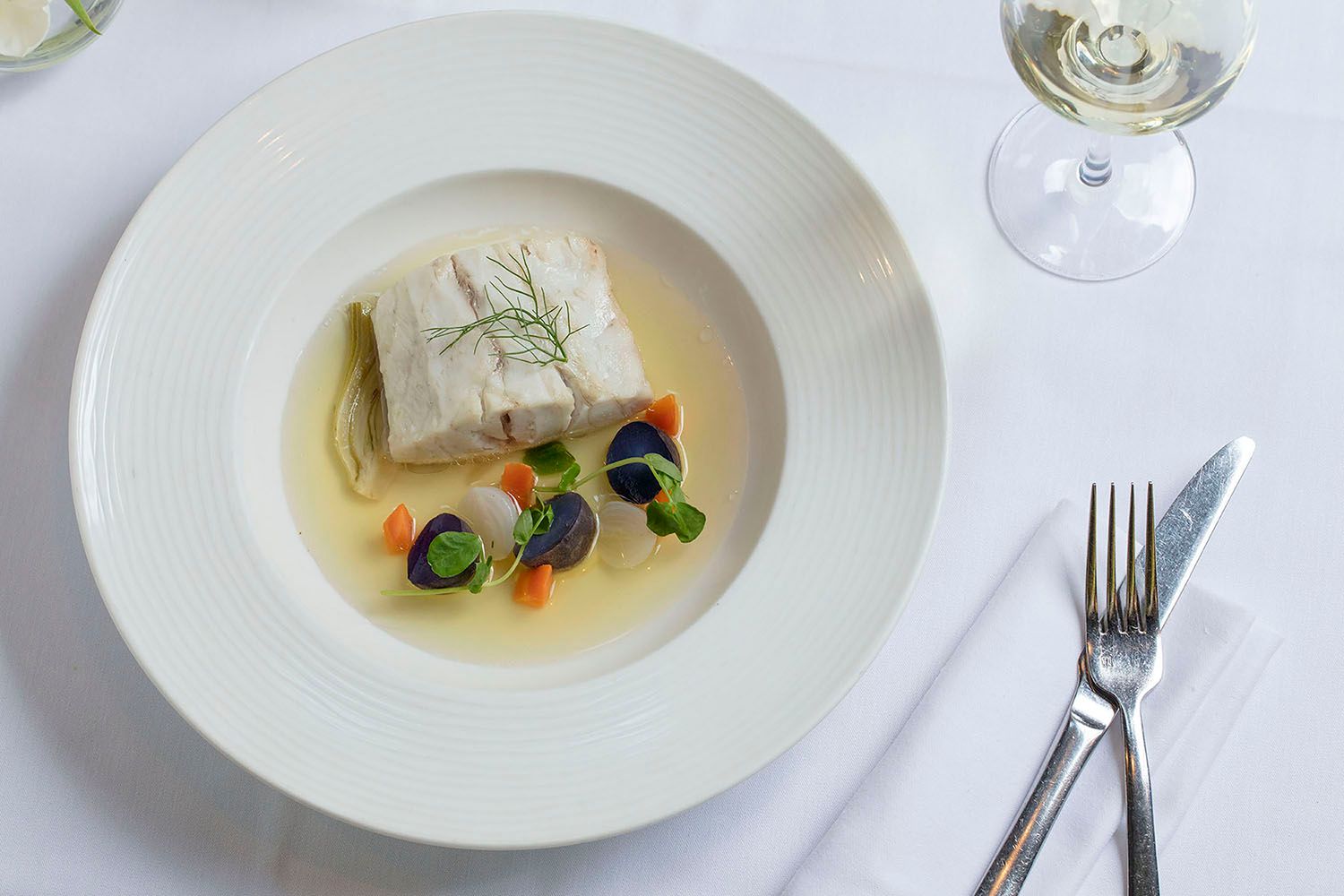 with
tarama
espuma and sherry vinaigrette ($28).
with
tarama
espuma and sherry vinaigrette ($28).
You expect grilled octopus to be on a Greek
menu and Nerai's is excellent, served over
Santorini fava beans with caramelized onions,
roasted red peppers and capers ($29).
There is a raw section of the menu with
shellfish and crudi, and some applaudable
pastas I had not expected, including summery lemon
gnocchi with
chanterelles, feta, spinach and pine nuts ($29),
and a truly outstanding mounting of abundant
lobster with squid ink linguine (above) in
a Metaxa bisque ($46).
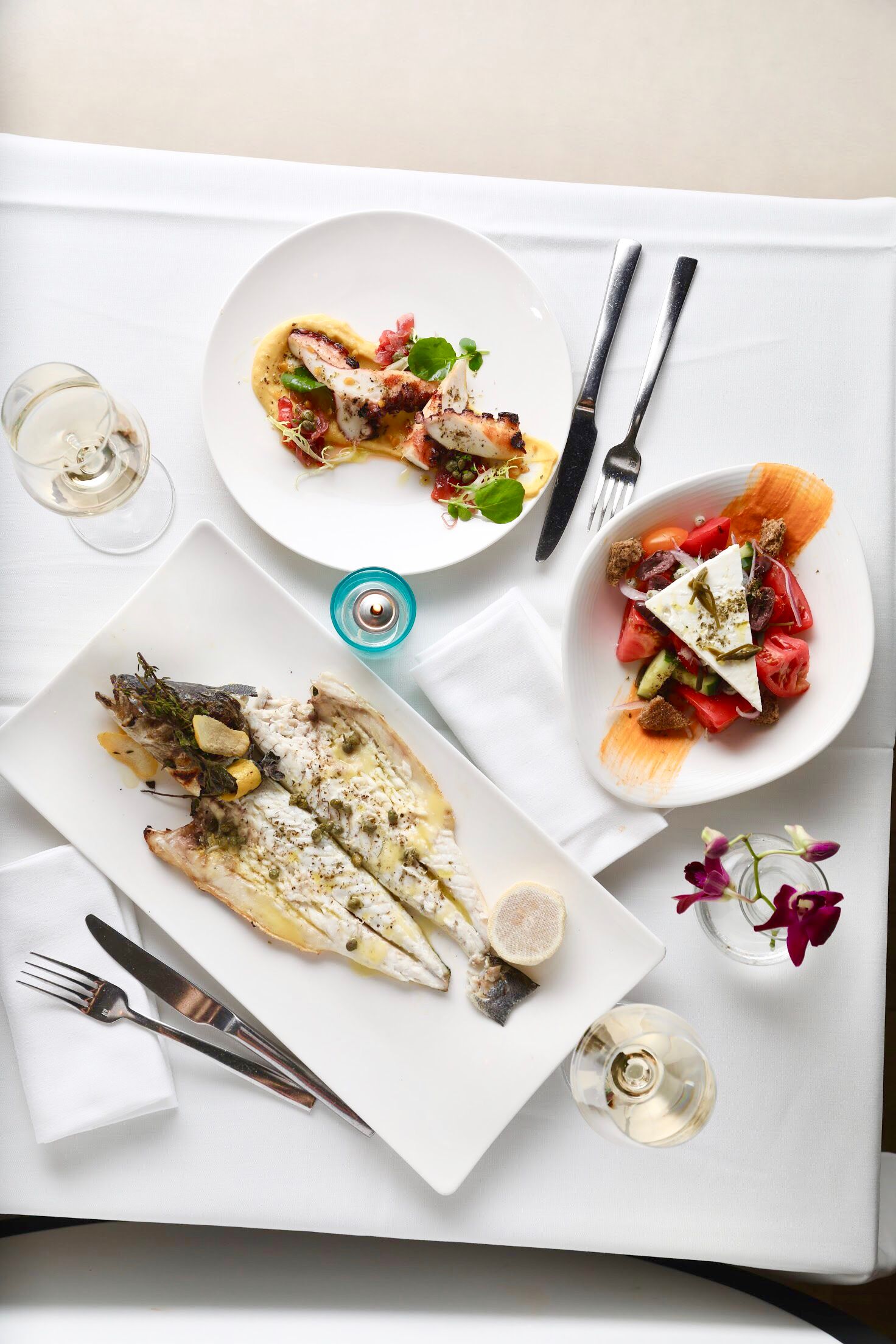 Grilled seafood is always the way to go at
Mediterranean restaurants, where
you trust they will be expertly cooked to
succulence, as is the lavraki (left)
with sautéed spinach ($42),
and the firm-fleshed halibut (above),
pan-roasted à
la polita with artichokes, saffron pickled
onion and mint ($48). I asked Fitterman why he is
bothering to serve salmon in a Greek restaurant
and got the answer I expected: He sells tons of
it.
Grilled seafood is always the way to go at
Mediterranean restaurants, where
you trust they will be expertly cooked to
succulence, as is the lavraki (left)
with sautéed spinach ($42),
and the firm-fleshed halibut (above),
pan-roasted à
la polita with artichokes, saffron pickled
onion and mint ($48). I asked Fitterman why he is
bothering to serve salmon in a Greek restaurant
and got the answer I expected: He sells tons of
it.
Fitterman has not, however, acceded to
serving inferior lamb, but is buying some of the
finest Colorado lamb chops I’ve had in years, so
flavorful, with a fine char on the bones, served
over melitzanosalata with marinated eggplant,
Samos currants, pine nuts and lamb jus ($52).
His duck “moussaka” is a delicious dish
made with pan-seared duck breast over beluga
lentils and chanterelles fig jus
($44), but it bears no resemblance at all to the
layered Greek lasagna that is moussaka. Better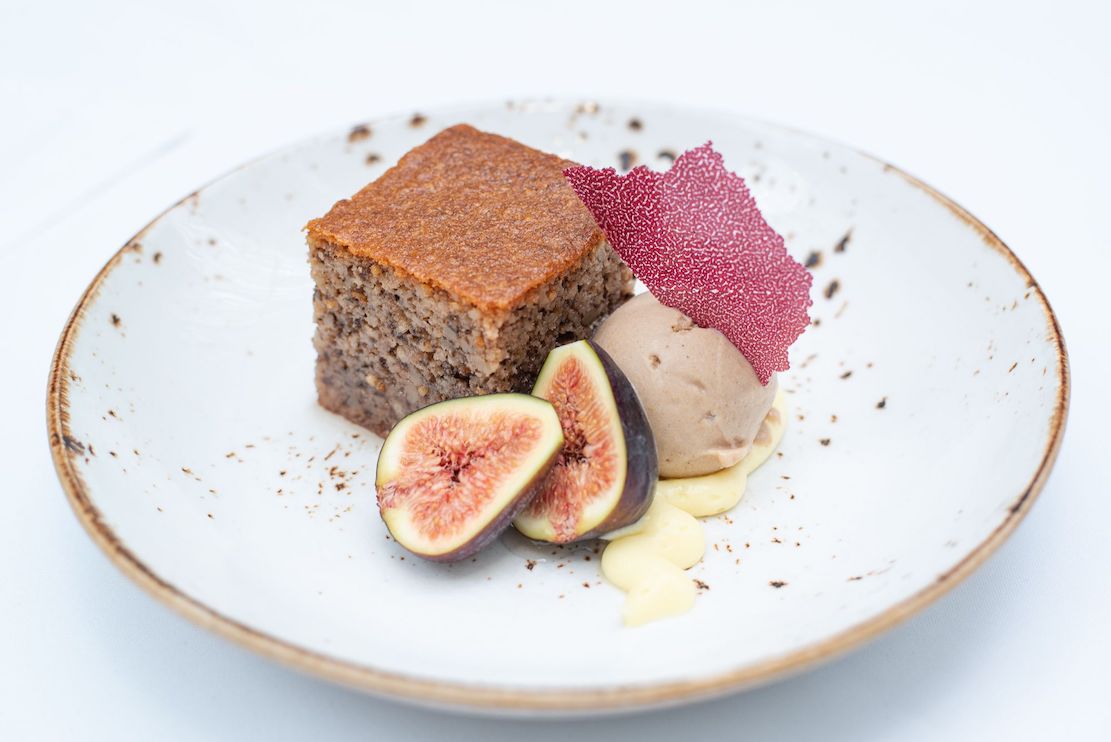 he should ditch the name or add a true moussaka to
the menu. By the way, a side of lemon-drenched
potatoes ($12) is definitely in order for the
table.
he should ditch the name or add a true moussaka to
the menu. By the way, a side of lemon-drenched
potatoes ($12) is definitely in order for the
table.
It’s always tempting just to savor some
rich Greek yogurt for dessert, and Nerai offers a
trio at $12. But I wouldn’t want you to miss the sokolatina,
a milk chocolate mousse and flourless chocolate
cake with raspberries
and vanilla
gelato ($16),
or the karidopita,
a luscious walnut cake (right) soaked with milk and
honey glaze with a Greek yogurt gelato ($14). Of
course, there is well-rendered baklava, with a
tahini parfait and vanilla gelato ($15).
Like many
Italian trattorias in the U.S., Greek restaurants
tend towards a casual, taverna style, both in
design and menu. Nerai has always aimed higher in
both, and, after ten years, with an enthusiastic
new chef, it is certainly among the ranks of the
finest French and Italian restaurants in New York.
And rain or shine, it’s going to make you feel you
are in a special place.
Open Mon.-Fri. for
lunch and dinner; Sat. & Sun. for dinner.
ANOTHER VERMEER

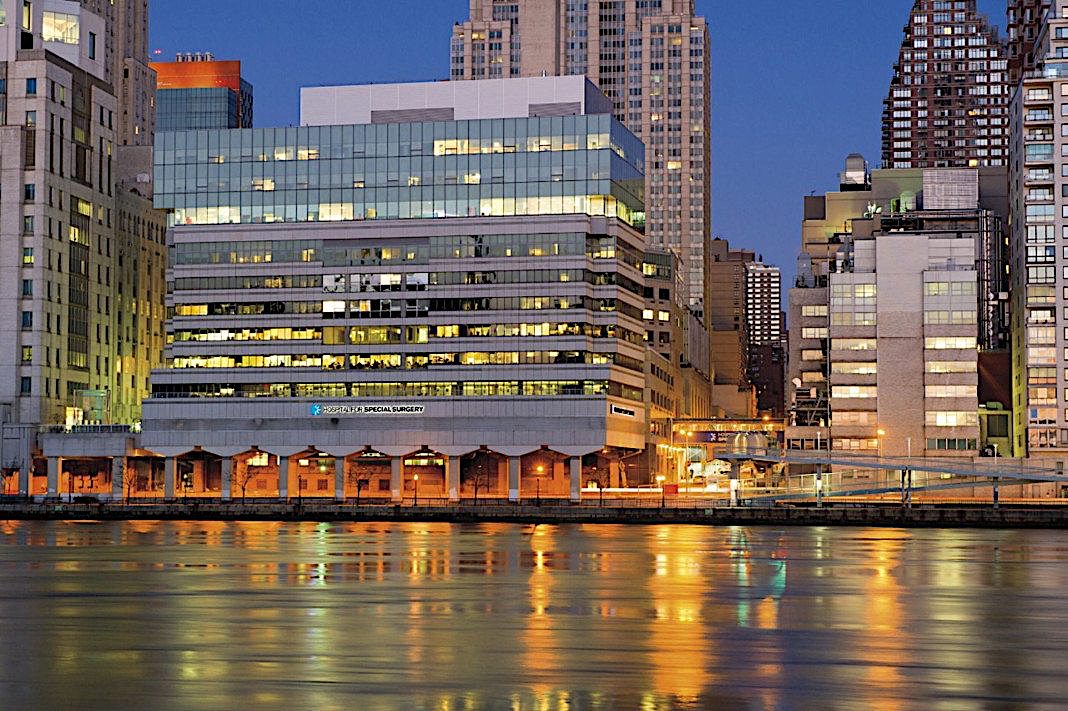 Robert Lauden’s injuries were
significant, but not life-threatening—his left arm
was smashed, his hip broken, three cracked
ribs—so he was in a great deal of pain, but
not enough to prevent him from calling Katie
to thank her and ask her to visit him in the
orthopedic wing of New York’s Hospital for
Special Surgery (left), to which he was
a consistent donor.
Robert Lauden’s injuries were
significant, but not life-threatening—his left arm
was smashed, his hip broken, three cracked
ribs—so he was in a great deal of pain, but
not enough to prevent him from calling Katie
to thank her and ask her to visit him in the
orthopedic wing of New York’s Hospital for
Special Surgery (left), to which he was
a consistent donor.
David accompanied her to the hospital the
day after the accident and found the billionaire
sitting up in bed, heavily bandaged on his left
side, with dark gray-blue-and-red bruises on the
skin. He
looked drowsy.
“How are you feeling?” asked Katie.
“Ah, they’re doing wonders with pain
killers these days!” said Louden. “You know, I
never took recreational drugs, but these things
do have their virtues.” He shook his head,
crossed his eyes and waggled his tongue, then
thanked Katie profusely for saving his life.
“I’m glad to hear you’re in good
spirits,” Katie said, then introduced David
Greco as someone helping with her story.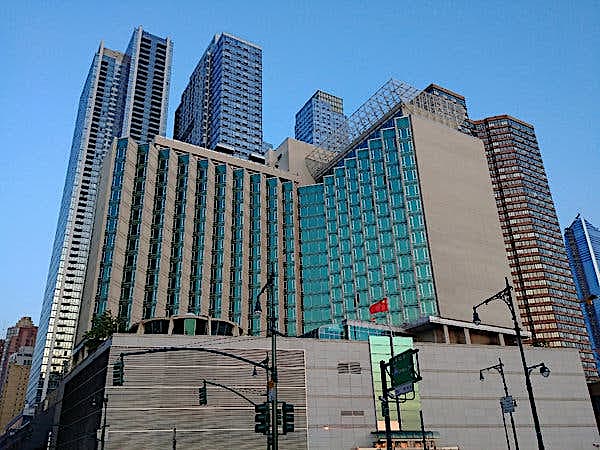
“You are a New York police officer?”
asked Louden.
“Retired, just helping Katie with her
research,” said David.
“So tell me what you know about this
creep that hit me and drove away.”
“Turns out he’s attached to the Chinese
embassy,” (below) said David. “The police
caught up with him within half an hour.”
“The Chinese embassy? (right) And
they have him in custody?”
“Not yet. He and the embassy are claiming
diplomatic immunity.”
“Diplomatic immunity? The guy practically
kills me, then leaves the scene. Diplomatic
immunity covers that?”
“I’m afraid it might, depending on the
Chinese. The guy doesn’t seem to be high up;
he’s not the ambassador but seems to be part of
their delegation at the U.N.”
“That’s unbelievable!” shouted Louden.
“Who’s leading the investigation?”
“NYPD. It’s their jurisdiction, but I
suspect the feds will try to arrest this guy and
have him tried, but it’s going to be tough.”
“He can just get away with smashing into
me and driving off? I
could have been killed.”
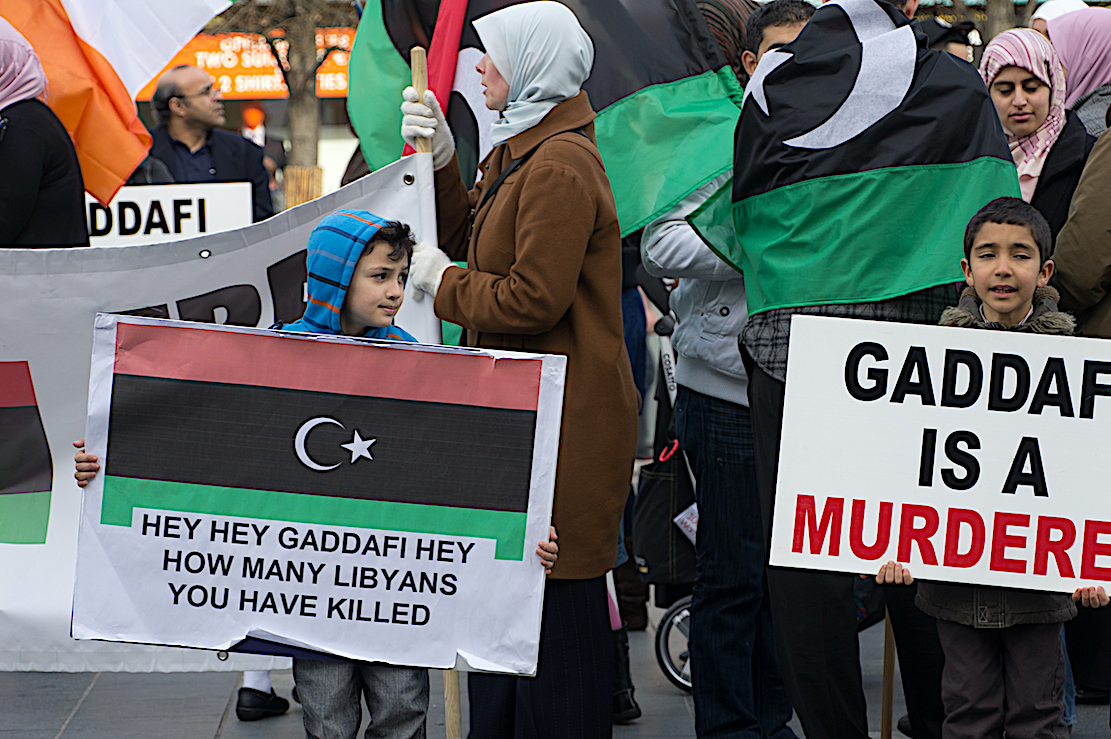 David glanced at Katie and
said, “It’s very possible. You can’t believe
what these embassy people have gotten away with,
and I’m not just talking about a few hundred
parking tickets. Back in the eighties a Libyan
embassy worker opened fire on a mob of
anti-Gaddafi protesters outside the embassy.
Killed a cop—I knew her—and wounded ten others. After
an eleven-day siege of the embassy by NYPD, the
embassy shipped the guy back to Libya and he was
never heard from again.
David glanced at Katie and
said, “It’s very possible. You can’t believe
what these embassy people have gotten away with,
and I’m not just talking about a few hundred
parking tickets. Back in the eighties a Libyan
embassy worker opened fire on a mob of
anti-Gaddafi protesters outside the embassy.
Killed a cop—I knew her—and wounded ten others. After
an eleven-day siege of the embassy by NYPD, the
embassy shipped the guy back to Libya and he was
never heard from again.
“Another time a Burmese ambassador shot
his wife for having an affair, then burned her
body on a funeral pyre in his backyard. He was
never convicted and remained the Burmese
ambassador.”
“I can’t believe this,” said Louden,
shaking his head. “You know, I’ve worked with a
lot of powerful Chinese officials over the
years. I’m going to call every goddamn one of
them and make them do something.”
Louden was well aware that the incident
was a hit-and-run felony, but he had not
considered it was an assassination attempt. He
had not yet been interviewed by NYPD.
“Mr. Louden,” asked Katie, “do you have
any reason to suspect this was not an
accident?”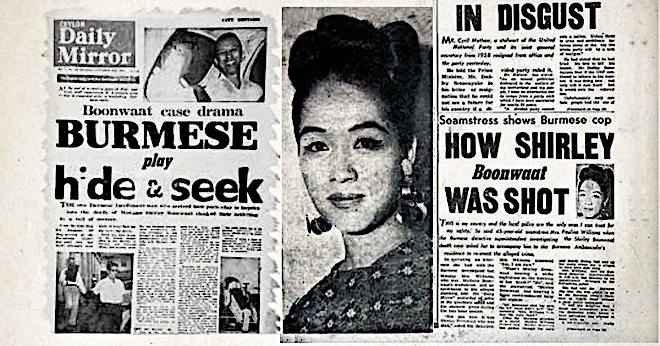
“You mean that the guy intended
to kill me?
A guy from the Chinese embassy who
couldn’t possibly get away?”
“I know it sounds bizarre, and maybe the
guy just panicked and drove away thinking his
embassy would protect him. But he
didn’t even brake or stop at all when he hit
you. He just hit you and kept driving. It seems
difficult to believe anybody who accidentally
hits a person on the sidewalk wouldn’t at least
stop for even a split second to consider what
he’d done, even if he panicked and drove off.”
“I have to agree with Katie,” said David.
“There’re only two kinds of hit-and-run
incidents: an accident or an attempted murder.
Now, like Katie said, maybe the guy thought if
he got back to his embassy he’d get sanctuary
there. But
from what Katie saw, it appeared he gunned his
car, hit you and had every intention to keep on
going.”
“Just like that?” asked Louden. “Even if
he intended to murder me, you think he was just
waiting, parked on the street in case I come out
of my house?
Gramercy Park’s security people are very
suspect of any cars they don’t know.”
“Yes, but he had diplomatic plates. With
those, he can park anywhere he wants whenever he
wants. If
he gets towed, his embassy just sends someone to
pick up the car.
No fine, no penalty.”
“And, as for his waiting for you to come
out of your house,” added Katie, “you did tell
me that you take a long walk in the park every
day at eleven o’clock.”
Louden’s face fell. “Oh, my God, you’re
right. I do that every day. He
must have been tracking me in advance.”
“So let me ask you again, Mr. Louden,”
said David. “Is there anyone you know who would
want to murder you? Anyone
at all?”
“I’m not going to joke around about this.
No, I can’t think of anyone—least of all a
Chinese embassy delegate—who’d want me dead.
Sure, I have people who hate my guts, largely
for business reasons, but this connection to the
Chinese makes no sense whatsoever.”
At that moment there was a slight knock
at the hospital room door, and two NYPD
officers, one plainclothes, asked if they might
come in. They saw David, and the plainclothes
detective said, “Greco, what are you doing here? I
thought you were planting flowers up the
Hudson.”
“How’s it going, Jimmy? Long time no see.
How’s Lynn and the kids?”
The niceties were brief and the
detective, Jimmy McCann, apologized to Louden,
introduced himself and his partner and asked if
he would agree to an interview. Louden looked at
David, who nodded okay, and replied, “I guess
so. Not too long, though. I may fall asleep on
you, and I don’t want to miss the delicious
lunch they serve me, the one I refuse to eat.”
McCann told his partner, “Why don’t you
get the preliminary info with Mr. Louden? I want
to speak to my old friend here.”
David and Jimmy
McCann had known each other for a decade and
even worked on a few mob cases together. McCann
was a few years younger than David but close to
retirement.
“So, David, what are you doing here with
a good-looking woman half your age?”
“She’s not half my age, Jimmy, all right? Anyway,
she’s a reporter for McClure’s
magazine . . .”
“Oh, the Capone case! Yeah,
I read that. Didn’t believe everything in the
story, but, hell, made you into a kinda hero. I
expect you made some money, too.”
“It was a good chunk of change.”
“So, listen, David, what are you doing in
this hospital room interviewing a injured gay
billionaire?”
“I’m helping Katie with another story.
Louden is a big art collector and Katie was
interviewing him at the time of the incident.
Saw him get hit, copied down the license plate.”
“What’s the story about?” asked McCann.
“Not that you’d know anything about this,
but there’s a big deal painting by a Dutch
artist coming up for auction, and Louden is
probably going to be one of the bidders.”
“And you just came by with your
girlfriend to chat with the guy?”
David just shrugged. He was not about to
tell McCann his theory about someone trying to
put potential bidders on the Vermeer out of
commission.
McCann’s job was to find out what
happened yesterday and work with the authorities
to get the Chinese delegate—whose name they’d
already found out was Chin—out of the embassy
and into interrogation.
“Yeah, good luck with that,” said David.
“I know, I know. I’m just here to get
Louden’s statement and then it all gets handed
over to the top brass, or probably the F.B.I. Chin
will walk; you know that. So, let’s you and me
and Lynn and your girlfriend have dinner
together sometime soon, eh?”
“Love to,” said David, knowing that would
probably never happen. Cops don’t care much to
sit around and hear retired cops’ stories, and
wives really hate it.
McCann returned to Louden’s bedside,
where the other officer was asking questions.
David silently indicated to Katie they should
leave, and when they turned to do so, Louden
said, “Katie, come visit anytime. And
Katie, thank you, thank you, thank you
again for saving my life.”
David said to her outside, “Something
tells me you’re going to get a nice present from
Louden.”
“Which I can’t accept, if it’s over $25.”
“Well, then, you’re definitely not going
to be able to accept it.”
Having turned off their cell phones in
the hospital, when Katie and David turned them
on there were multiple messages. Katie
had a call from her editor Dobell; David had one
from Kiley.
Dobell was just calling to
nudge Katie to give him enough news so as not to
pull the leash back.
“Gerald, you called?” asked David.
“Yes, I got through to the medical
examiner in Tokyo about the Saito autopsy.”
“And?”
“And it was inconclusive.”
“Was it a forensic or a clinical.”
“As far as I can tell—the guy spoke lousy
English—clinical. They think Saito died of
natural causes, heart failure maybe, although he
seems to have gone into shock. They found he had
heart disease—he was a big smoker—and had
apparently contracted syphilis when he was a
young man and apparently didn’t get treatment
for that until he was much older. Oh,
they found some traces of arsenic in his blood,
which was probably used to treat the syphilis.
And that’s about it.”
"They treat syphilis with arsenic?"
“I guess in Japan they do. I’m not a forensic
scientist.”
“But there were just traces, they told
you.”
“As far as I could make out, the way the
guy talked.”
“Well, that’s something of interest. But as
far as it goes, Gerald, they found no evidence
of foul play in his death?”
“No, they closed the book on Mr. Saito. A
lot of people apparently said good riddance.”
“Okay, thanks a million for making the
call. I owe you big time. Let’s keep in touch
with what both of us find out.”
Drawing back into his official voice,
Kiley replied, “I’ll give you what I can.”
“By the way, have you heard about the
hit-and-run incident yesterday on Robert Lauden? Turns
out the driver is attached to the Chinese
embassy.”
“Jesus Christ! No, I hadn’t read that.
This is getting weird, David.”
“It sure is,” said David and he filled in
all the details he had thus far and how the NYPD
had tried to arrest the man named Chin, who was
safely protected inside the embassy, over on
Twelfth Avenue.
“Would Interpol get involved in something
like getting him out of there?”
“Again, if there’s a proven crime that
relates in some way to an international scheme,
maybe. Otherwise, that’s strictly the F.B.I.’s
ballpark. Hey,
maybe you should call Frank English, see what he
knows.”
David groaned and said, “I hate asking
Frank for any more favors.”
“I’ll do it then and let you know what he
says. He’ll probably ask about you.”
“Give him my love.”
© John Mariani, 2016
❖❖❖
An Interview with G.H. Mumm
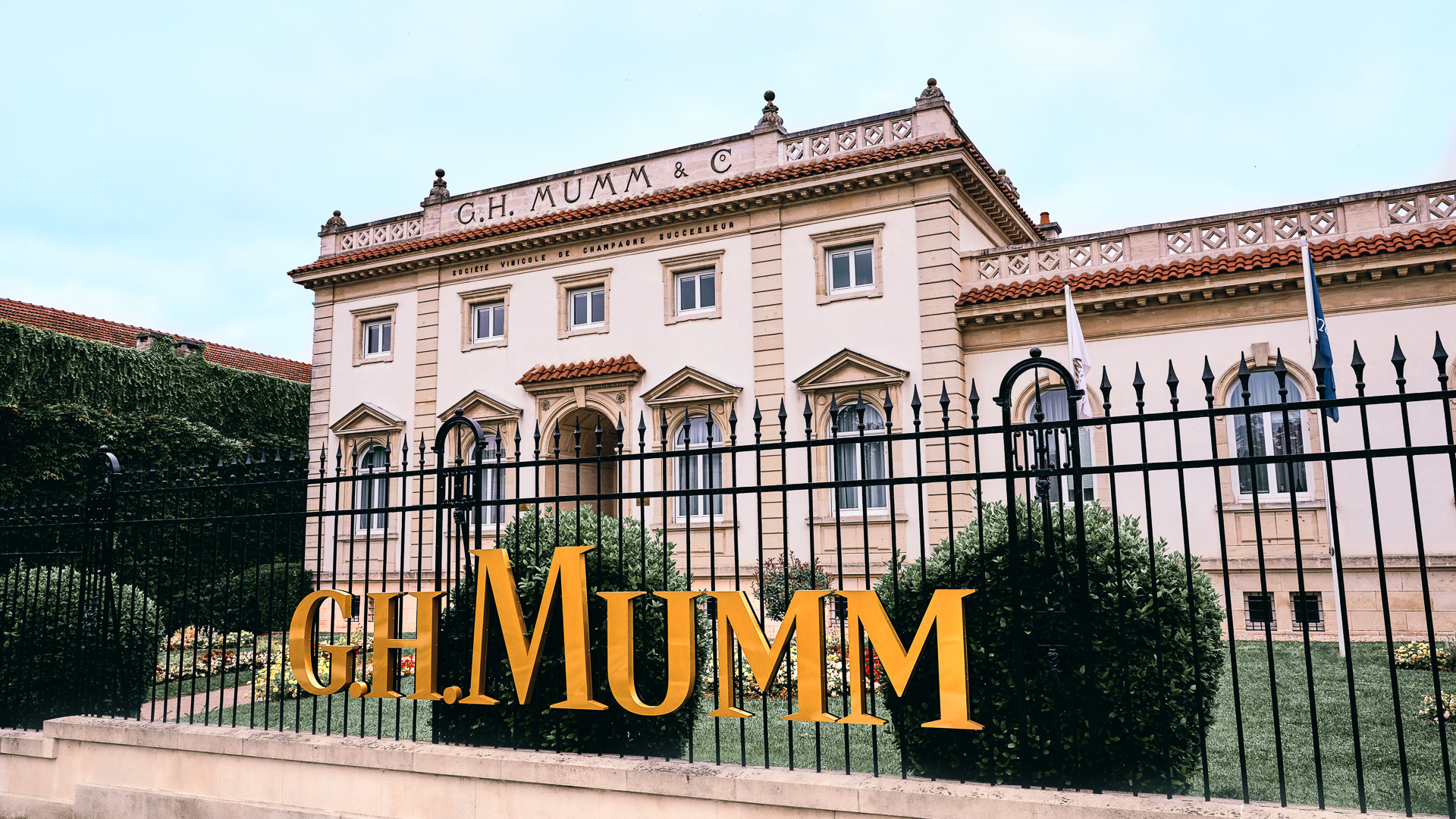
By John Mariani
With so
many sparkling wine competitors in the world
market, from Spain, Italy and California,
Champagne has managed to maintain a healthy growth
rate, even with the introduction of smaller
estates in Reims and Epernay joining the big
established marques. To assess the current state
of Champagne, I interviewed Laurent Fresnet,
Cellar Master at G.H. Mumm, while he
was visiting New York last month.
Can you to describe
Mumm’s distinctiveness among Champagne houses
without using the cliche “elegant”—how Mumm
differs in style, taste, etc from others?
I tend to sum up Mumm’s
style as “the celebration of Pinot Noir.” This grape
variety is the signature of the house and the
backbone of all our cuvées. This allows us to
produce fresh, vibrant, and complex champagnes,
expressing the full richness of the Champagne
terroirs. From the outset, we have always held our
champagnes in the highest regard, always putting
quality first. This approach would be encapsulated
in our “only the best” motto coined by Georges
Hermann Mumm, and in today’s innovative approach to
winemaking and vineyard management.
Mumm was one of the
pioneers in the 19th century to purchase grapes
rather than juice from local growers. What
percentage of Mumm’s production comes from these
growers today?
Maison Mumm’s own vineyards
cover 218 hectares. The vineyards, in which Pinot
Noir is highly dominant (78%), particularly in the
Montagne de Reims, spread over the Grand Cru
vineyards of Cramant and Avize devoted to Chardonnay
in the Côte des Blancs and the Vallée de la Marne,
where Meunier prevails.
To answer Maison Mumm's
production needs, we work with partner winegrowers
who supply us with grapes. This represents up to 75%
of our needs, depending on the year, which is a
rather low share for a Grande Maison. This allows us
to get grapes from a variety of terroirs where we do
not own plots, and thus ensure the expression of the
richness of Champagne year after year.
When were the Grand
Cru sites established?
The official échelle des
crus Champagne vineyard classification of
1911, which is still in use today, rates vineyards
in relation to criteria such as soil quality,
exposure to the sun, and grape varieties planted.
Out of a total of 319 communes, this classification
identifies seventeen villages as Grands Crus (the
very best terroirs in the Champagne region) and 42
other villages as Premiers Crus. At Maison Mumm, our
vineyard is ranked 98 on the Champagne quality
scale. Out of 218 hectares, 160 hectares are
classified as Grands Crus and are situated in eight
historic villages whose grapes express all of the
authenticity of the Champagne region’s best
terroirs: Aÿ, Bouzy, Ambonnay, Verzy, Verzenay,
Mailly, Avize, and Cramant.
If every house
strives to make their Champagne taste precisely
the same each year, because the customers enjoy
that particular house style, why are there so many
variants (besides vintage years), which would by
their very nature taste somewhat different? What
is the price spread between the basic Cordon Rouge
and others?.jpg)
The consistency in taste is
only for non-vintage cuvées; the objective is to
produce year after year the same cuvées. With
vintage cuvées, we want to maintain a certain style
for each cuvée but also showcase the expression of
the year. We have a range of cuvées, all different,
all showcasing what I call a “different
personality.” In the case of Mumm, we want each
cuvée to reveal a different facet of Pinot Noir, our
signature grape variety. All those cuvées answer to
different taste preferences and different
occasions.
How is Mumm devoted
to sustainability?
For a Champagne house like
us, sustainability starts in the vineyards. As a
native of Champagne and owner of a family vineyard,
taking care of the land is crucial for me and
something that I want to ensure for Maison Mumm. In
2016, 100% of Maison Mumm vineyards obtained a
double certification for Sustainable Viticulture in
Champagne and High Environmental Value. Whereas the
Champagne region as a whole aims to stop using
chemical herbicides by 2025, Maison Mumm is one of
the first champagne houses to have already done so,
having implemented a zero-herbicide policy on its
own parcels at the beginning of 2016. In its quest
to eliminate herbicides and improve the working
conditions of its employees in the vineyards, Maison
Mumm is one of the first champagne houses to adopt
Bakus, a robot designed by a Reims-based startup,
Vitibot, which assists winegrowers in tending the
vines, most notably with the physically demanding
task of weeding. The house is exploring other means
to reduce its environmental footprint, through
growing practices and machinery, such as the use of
green fertilizers, alternative treatments, confined
spraying, and electric trimming trolleys.
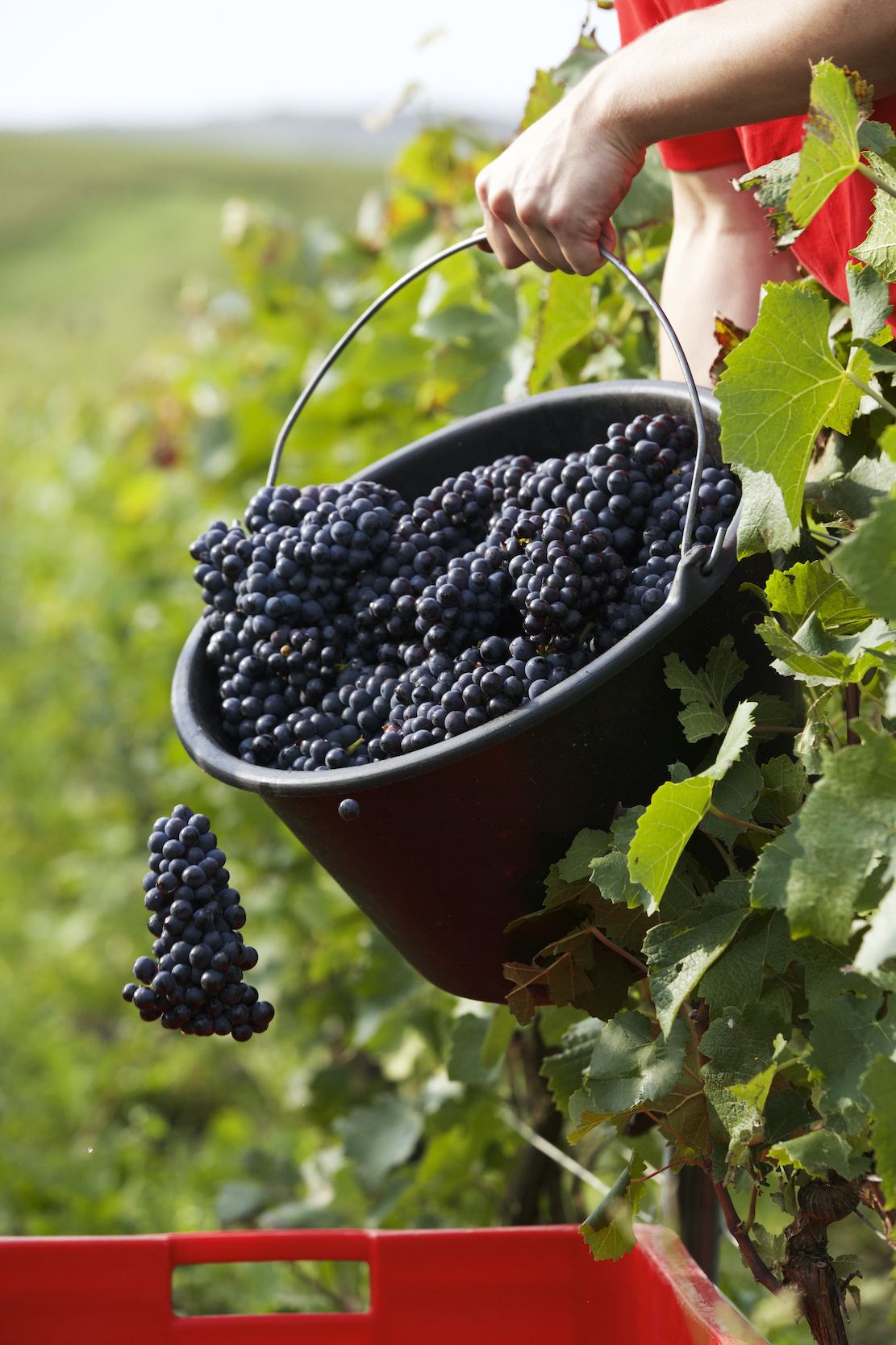 Since 2021, we have
dedicated part of our vineyard for experimentation
with a new viticultural model—“regenerative
viticulture.” The objective of this approach is to
ensure the health and quality of our soils, as well
as foster biodiversity, mitigate climate change, and
reduce soil erosion. We start by analyzing the
soil's needs, and based on the need, we introduce
new cultures (clovers, legumes, flowers, …) that
will help the soil. This is a very innovative and
new approach to traditional viticultural
practices. But we do not limit our commitment
to the vineyard and try to reduce our impact at all
stages of production, including winemaking. We are,
for example, the first house in Champagne to invest
in wine stabilization through electrodialysis,
having recently acquired a new vat room machine for
the purpose. This is an important investment for the
house that allows energy savings of approximately
85%.
Since 2021, we have
dedicated part of our vineyard for experimentation
with a new viticultural model—“regenerative
viticulture.” The objective of this approach is to
ensure the health and quality of our soils, as well
as foster biodiversity, mitigate climate change, and
reduce soil erosion. We start by analyzing the
soil's needs, and based on the need, we introduce
new cultures (clovers, legumes, flowers, …) that
will help the soil. This is a very innovative and
new approach to traditional viticultural
practices. But we do not limit our commitment
to the vineyard and try to reduce our impact at all
stages of production, including winemaking. We are,
for example, the first house in Champagne to invest
in wine stabilization through electrodialysis,
having recently acquired a new vat room machine for
the purpose. This is an important investment for the
house that allows energy savings of approximately
85%.
Global warming is
not always a bad thing (yet) for cooler climate
vineyards. How has it affected the Champagne
region?
The impact of global
warming is already concrete in Champagne. We see
more and more disruptions in climate and an
acceleration in recent years. With higher
temperatures and warmer winters, we tend to see the
flower blooming earlier, creating stronger risks of
spring frost. But we also tend to see the period
between the flower and the harvest as considerably
shorter. When it was approximately 100 days, with
harvest in early October, 20 to 30 years ago, today
it is more around 85 days, with August harvests
becoming the norm.
The bigger risk for Champagne is
the reduction of the acidity and a disbalance
between acidity and sugar. This balance is crucial
to maintain the characteristic freshness of
Champagne and its long potential for aging. I work a
lot with the vineyard teams to ensure the management
of our vines and extremely precise monitoring of the
grapes prior to the harvest.
When did Mumm begin
to make a prestige Cuvée?
In the history of Mumm,
there have been several prestige cuvées produced.
The current, Mumm RSRV Cuvée Lalou was created in
1969, paying tribute to René Lalou, director of Mumm
between 1940 and 1973. This cuvée is a blend of 50%
Pinot Noir and 50% Chardonnay, 100% Grand Cru, from
a selection of only 12 pristine plots, with an aging
of a minimum 8 years, making it the rarest and
finest of the Mumm collection.
Too often the
Champagne industry warns that there will be a
shortage (e.g., the Millennium), but there seems
always to be millions of bottles available. Is
there ever really a shortage, especially since
there are so many smaller producers in the market?
The Champagne appellation
is strictly limited geographically and in terms of
yields. Therefore, we have only a limited quantity
of Champagne available. The current booming demand
and the last 2 years of low yields create tensions
between demand and supply. Champagne is a long
process that takes time, between 2 to 8 years for a
bottle at Mumm. We work closely with all our
customers and distributors to ensure a smooth
distribution of our products all around the world,
but at the same time, we must ensure quality and we
do not comprise on quality by reducing the aging
phases for example.
Spanish cava,
Italian proseccos, and California sparklers have
had an enormous impact over the last decade in the
sparkling wine market. How has that affected
Champagne?
Champagne is Champagne. The
terroir, the climate, and the savoir-faire are
unparalleled and the style inimitable. For me, there
is room for all types of sparkling wines, and I do
not see the others as competitors, but more as a
complementary offer for different
occasions.
Is there a conscious
effort to maintain a price level in the face of
such competition?
As mentioned earlier,
Champagne is a demanding and long process, with
grapes coming from a very limited geographic area,
so I let you do the math, but
producing Champagne is expensive, especially fine
Champagnes like Mumm’s.
Is there really such
a difference between a basic label and a prestige
Cuvee that may cost hundreds of dollars?
The price difference
between a classic non-vintage cuvée like Mumm Grand
Cordon and a prestige cuvée like Mumm RSRV Cuvée
Lalou comes from the rarity and the demanding
process, especially the long aging on lees. Mumm
RSRV Cuvée Lalou is produced from only a maximum of
12 pristine plots and only the best years. We have
only produced 17 vintages since 1969. This cuvée
ages a minimum of 8 years on lees, allowing the
development of character and deep complexity.
What meats work with
Champagne?
For me, Champagne is first
and foremost a wine, and tasting Champagne during a
meal is the best way to enjoy both! We work
with a lot of talented chefs to create the best
pairings. Champagne and meat can pair very well,
even red meat. I love a barbecue grilled steak with
a glass of rosé champagne like Mumm Grand Cordon
Rosé or Mumm RSRV Rosé Foujita. Poultry and white
meat like veal pair perfectly with brut champagnes
like our Mumm Grand Cordon, the freshness and
delicate texture are very complementary. Lamb with a
light spicing can work very well with 100% Pinot
Noir Champagne like our Mumm RSRV Blanc de Noirs. I
always encourage our customers and chefs to be bold
and dare new pairings!
❖❖❖
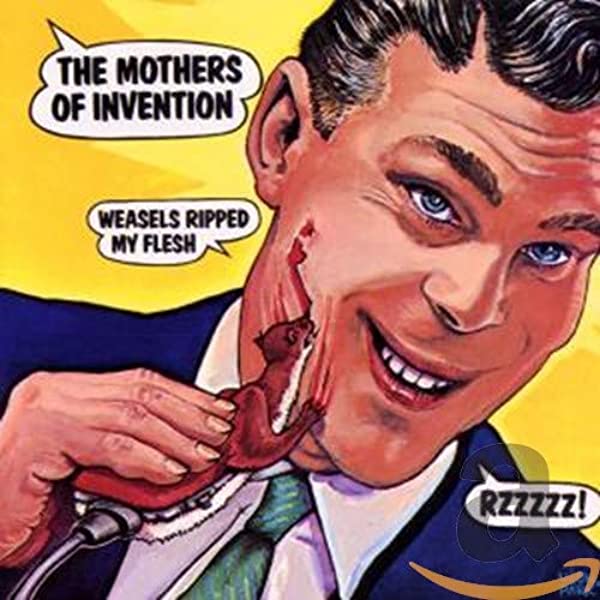 WE HIGHLY
RECOMMEND HER NEXT MEAL SHOULD
WE HIGHLY
RECOMMEND HER NEXT MEAL SHOULD
BE FROM FRANK ZAPPA'S WEASELS RIPPED MY
FLESH.
“I’m single, and I’ve been single for one million
years, and want to judge these lyrics on their
merits. To do so, I ate and drank my way through
every food and beverage reference on the album,
treating myself the way Styles treats whoever it is
he’s singing about, which is probably Wilde. I’m
just sticking to those and not the lyrics about
gummies, coke, and pills, because apparently it’s
against company policy to expense drugs. In the
sensual spirit of Harry’s House, let’s
rate the album based on how it tastes.”—Rebecca
Alter, “I Ate All the Lyrics of Harry’s House,” Vulture
(5/27/22)
❖❖❖
Any of John Mariani's books below may be ordered from amazon.com.
 The Hound in Heaven
(21st Century Lion Books) is a novella, and
for anyone who loves dogs, Christmas, romance,
inspiration, even the supernatural, I hope you'll find
this to be a treasured favorite. The story
concerns how, after a New England teacher, his wife and
their two daughters adopt a stray puppy found in their
barn in northern Maine, their lives seem full of promise.
But when tragedy strikes, their wonderful dog Lazarus and
the spirit of Christmas are the only things that may bring
his master back from the edge of despair.
The Hound in Heaven
(21st Century Lion Books) is a novella, and
for anyone who loves dogs, Christmas, romance,
inspiration, even the supernatural, I hope you'll find
this to be a treasured favorite. The story
concerns how, after a New England teacher, his wife and
their two daughters adopt a stray puppy found in their
barn in northern Maine, their lives seem full of promise.
But when tragedy strikes, their wonderful dog Lazarus and
the spirit of Christmas are the only things that may bring
his master back from the edge of despair. WATCH THE VIDEO!
“What a huge surprise turn this story took! I was completely stunned! I truly enjoyed this book and its message.” – Actress Ali MacGraw
“He had me at Page One. The amount of heart, human insight, soul searching, and deft literary strength that John Mariani pours into this airtight novella is vertigo-inducing. Perhaps ‘wow’ would be the best comment.” – James Dalessandro, author of Bohemian Heart and 1906.
“John Mariani’s Hound in Heaven starts with a well-painted portrayal of an American family, along with the requisite dog. A surprise event flips the action of the novel and captures us for a voyage leading to a hopeful and heart-warming message. A page turning, one sitting read, it’s the perfect antidote for the winter and promotion of holiday celebration.” – Ann Pearlman, author of The Christmas Cookie Club and A Gift for my Sister.
“John Mariani’s concise, achingly beautiful novella pulls a literary rabbit out of a hat – a mash-up of the cosmic and the intimate, the tragic and the heart-warming – a Christmas tale for all ages, and all faiths. Read it to your children, read it to yourself… but read it. Early and often. Highly recommended.” – Jay Bonansinga, New York Times bestselling author of Pinkerton’s War, The Sinking of The Eastland, and The Walking Dead: The Road To Woodbury.
“Amazing things happen when you open your heart to an animal. The Hound in Heaven delivers a powerful story of healing that is forged in the spiritual relationship between a man and his best friend. The book brings a message of hope that can enrich our images of family, love, and loss.” – Dr. Barbara Royal, author of The Royal Treatment.
 |
The Encyclopedia of American Food and Drink by John F. Mariani (Bloomsbury USA, $35) Modesty forbids me to praise my own new book, but let me proudly say that it is an extensive revision of the 4th edition that appeared more than a decade ago, before locavores, molecular cuisine, modernist cuisine, the Food Network and so much more, now included. Word origins have been completely updated, as have per capita consumption and production stats. Most important, for the first time since publication in the 1980s, the book includes more than 100 biographies of Americans who have changed the way we cook, eat and drink -- from Fannie Farmer and Julia Child to Robert Mondavi and Thomas Keller. "This book is amazing! It has entries for everything from `abalone' to `zwieback,' plus more than 500 recipes for classic American dishes and drinks."--Devra First, The Boston Globe. "Much needed in any kitchen library."--Bon Appetit. |
"Eating Italian will never be the same after reading John Mariani's entertaining and savory gastronomical history of the cuisine of Italy and how it won over appetites worldwide. . . . This book is such a tasteful narrative that it will literally make you hungry for Italian food and arouse your appetite for gastronomical history."--Don Oldenburg, USA Today. "Italian
restaurants--some good, some glitzy--far
outnumber their French rivals. Many of
these establishments are zestfully described
in How Italian Food Conquered the World, an
entertaining and fact-filled chronicle by
food-and-wine correspondent John F.
Mariani."--Aram Bakshian Jr., Wall Street
Journal.
"Equal parts
history, sociology, gastronomy, and just
plain fun, How Italian Food Conquered the
World tells the captivating and delicious
story of the (let's face it) everybody's
favorite cuisine with clarity, verve and
more than one surprise."--Colman Andrews,
editorial director of The Daily
Meal.com. "A fantastic and fascinating
read, covering everything from the influence
of Venice's spice trade to the impact of
Italian immigrants in America and the
evolution of alta cucina. This book will
serve as a terrific resource to anyone
interested in the real story of Italian
food."--Mary Ann Esposito, host of PBS-TV's
Ciao
Italia. "John Mariani has written the
definitive history of how Italians won their
way into our hearts, minds, and
stomachs. It's a story of pleasure over
pomp and taste over technique."--Danny Meyer,
owner of NYC restaurants Union Square
Cafe, The Modern, and Maialino.
|
 |
 |
 |
 |
 |
 |
 Everett Potter's Travel Report:
Everett Potter's Travel Report: 
 Eating Las
Vegas
Eating Las
Vegas
MARIANI'S VIRTUAL GOURMET
NEWSLETTER is published weekly. Publisher: John Mariani. Editor: Walter Bagley. Contributing Writers: Christopher
Mariani, Misha Mariani, John A. Curtas, Gerry Dawes, Geoff Kalish.
Contributing
Photographer: Galina Dargery. Technical
Advisor: Gerry
McLoughlin.
If you wish to subscribe to this
newsletter, please click here: http://www.johnmariani.com/subscribe/index.html
© copyright John Mariani 2022

